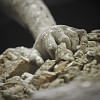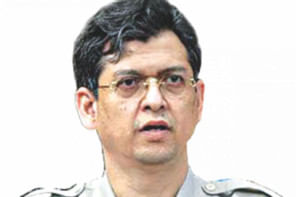A solemn walk through ‘Ten Years After Rana Plaza’

In a silent inauguration on July 21, immersive exhibition "Ten Years After Rana Plaza" kicked off at the level 2 of Drik Path Bhaban, Panthapath. The exhibition is composed of the interdisciplinary works of photojournalist Ismail Ferdous, curated to be displayed in a swirling walkway, designed by architect Farhana Nizam Chowdhury.

The exhibition started without any opening or celebration, as a solemn reminder of the tragic history and the aftermath of the event. Ismail Ferdous consciously chose not to arrange the exhibition in April, when the tragedy struck in 2013. According to him, instead of looking for an occasion to remember, this tragedy should be a part of the history that everyone remembers without fanfare, especially the younger ones.
"This exhibition is not for foreigners, this is for us Bangladeshis!" exclaimed Ismail, who does not like to call himself an activist but rather, a photojournalist. This sentiment is also apparent in the layout of the exhibition which is accessible for all, with the walkways being wide enough to accommodate wheelchairs and other facilities available, who are able to serve specially-abled individuals of all sorts.

Some of the artistes who have contributed to the making of the displayed collages include names like Morshed Mishu and Ata Mojlish. The photos displayed contained multiple styles of pictures, some portraits, some landscapes, but all of them shared the common subject of garment workers.
While the large photo of a crowd of garment workers commuting to work invokes a strange sense of omniscience, on the other side, the photo of a victim being pulled out of the rubble by volunteers, reluctantly makes the viewer feel the other side of the omniscience coin, the helplessness of being an observer.

"The first person that I talked to was the architect. That's where the core idea lies. Then I spoke to the artistes, on how to convey the sentiment of 'silence' "Ismail said to The Daily Star.
"If you look around, you will not see dramatic photos, rather quiet ones. To convey the moment of silence observed for all the lives that have been lost".
Dr Naomi Hossain, Research Professor at American University at Washington, DC and one of the organisers, remarked about the photos displayed, and shared her insights on the particularly harrowing effects the disaster had on the low-income female work force.
"Despite the tragedy, the industry has not stopped and they don't want it to either, they have mouths to feed." She then drifted off by complimenting the exhibition on its layered and nuanced vision, both literally and metaphorically.

Ismail, who was in France prior to coming to the country for this exhibition, currently works as a member of Agence VU in Paris. He had been photographing the Rana Plaza disaster and its victims since 2013, having taken breaks in between due to the sheer mental exhaustion that he faced as an onlooker of such a tragedy.
His photos of the tragic sight have been displayed in countless places, one of them being a projection onto the Lincoln Centre and stores, places that had sourced from the Rana Plaza, during New York Fashion Week, 2014.

The pièce de résistance of the exhibition, a portrait that Ismail had taken, is set at the last alley of the winding walkway. As per the artiste's request, the description of the photo has been kept secret, as that is something he wants the visitors to experience first-hand. All of the photos, collages displayed are tied to the structure and also the experience, which the photographer hopes will stir the hearts of the younger generations, from within.
The exhibition will remain open to the public every day until July 29, from 3 pm to 8 pm.

 For all latest news, follow The Daily Star's Google News channel.
For all latest news, follow The Daily Star's Google News channel. 









Comments